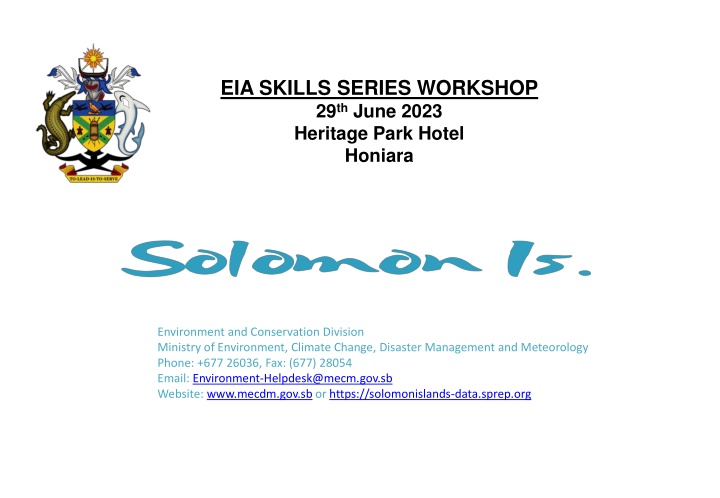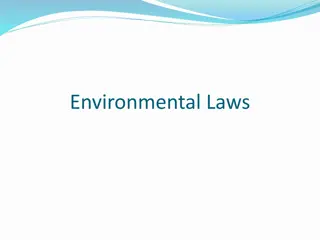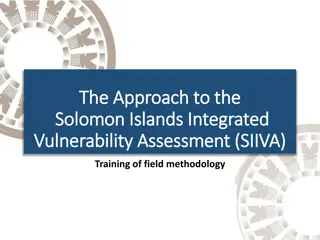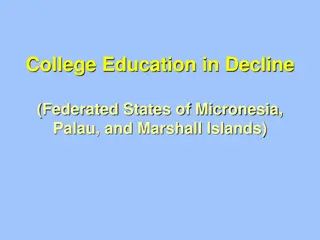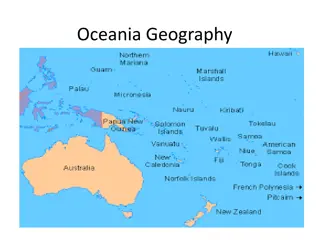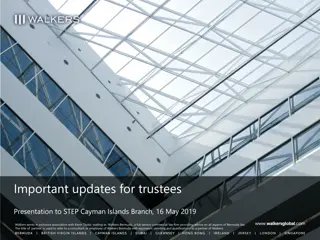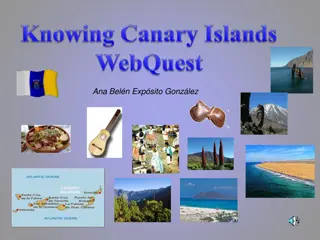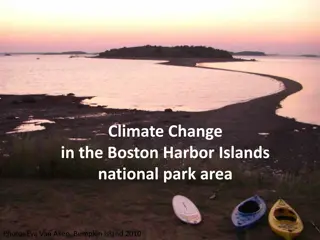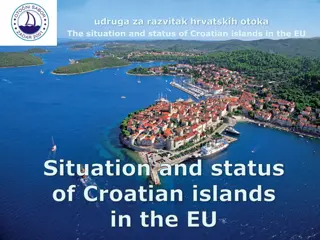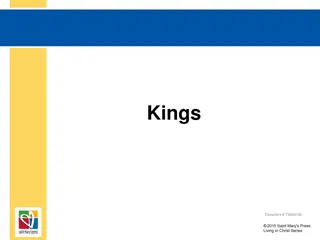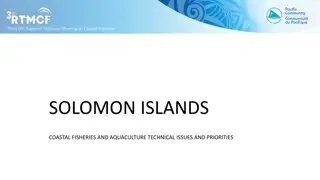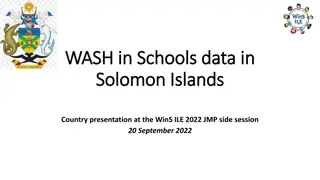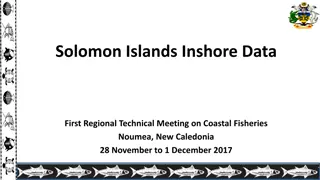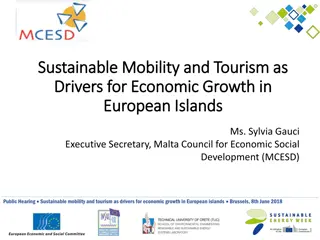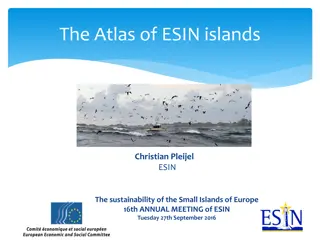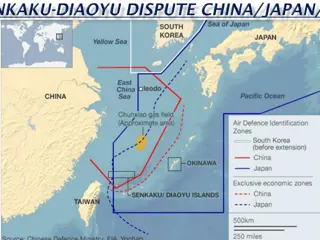Environmental Workshop Overview: Ministry of Environment in the Solomon Islands
The Environment and Conservation Division (ECD) of the Ministry of Environment, Climate Change, Disaster Management, and Meteorology in the Solomon Islands focuses on sustainable environmental management, conservation, and protection of natural resources. The ECD's vision is to safeguard the environment for the country's benefit, with a mission to enhance institutional capacity for environmental protection. Technical manuals like the Solomon Islands EIA Guideline 2010 support their efforts.
Download Presentation

Please find below an Image/Link to download the presentation.
The content on the website is provided AS IS for your information and personal use only. It may not be sold, licensed, or shared on other websites without obtaining consent from the author.If you encounter any issues during the download, it is possible that the publisher has removed the file from their server.
You are allowed to download the files provided on this website for personal or commercial use, subject to the condition that they are used lawfully. All files are the property of their respective owners.
The content on the website is provided AS IS for your information and personal use only. It may not be sold, licensed, or shared on other websites without obtaining consent from the author.
E N D
Presentation Transcript
EIA SKILLS SERIES WORKSHOP 29th June 2023 Heritage Park Hotel Honiara Environment and Conservation Division Ministry of Environment, Climate Change, Disaster Management and Meteorology Phone: +677 26036, Fax: (677) 28054 Email: Environment-Helpdesk@mecm.gov.sb Website: www.mecdm.gov.sb or https://solomonislands-data.sprep.org
OUTLINE Organization Framework Function of Environment & Conservation Division ( ECD ) Acts & Regulations Environmental Impact Assessment ( EIA ) Process Challenges in Implementing EIA Process
ORGANIZATION FRAMEWORK Name of Organization: Ministry of Environment Climate Change Disaster Management & Meteorology ( MECDM), Solomon Islands Structure of Organization: Minister PS COOPERATE Service MET Service ECD CCD NDMO
ORGANIZATION FRAMEWORK Vision: A safe, sustainable and resilient environment for Solomon Islands Missions of Organization: To provide an enabling environment for the safety and socio-economic development of Solomon Islands through application of necessary safeguards on: sustainable management of natural resources and protection of the environment Preparing for and responding to climate change, Leading and coordinating disaster risk management, Providing meteorological and allied services, Developing and providing the enabling environment for the planning and implementation of functions and technical services of the ministry.
ENVIRONMENT AND CONSERVATION DIVISION (ECD) VISION: To ensure the Environment and Natural Resources of Solomon Islands are protected, managed and sustainably used for the maximum benefit of the Government and people of Solomon Islands. MISSION: To improve and strengthen the national institutional and administrative capacity of the division to be able to promote the protection, conservation and sustainable management of the use of the environment and natural resources of Solomon Islands. Technical Manuals: Solomon Islands EIA Guideline 2010 and Protected Areas Toolkit.
FUNCTION OF ECD Responsible for the sound management & sustainable utilization of the country s natural resource base & better protection of its environment. It does this through: Environment Act 1998 & Environment Regulation 2008 Wildlife Protection & Management Act 1998; Wildlife Protection & Management Regulation 2008 Protected Areas Act 2010 and Protected Areas Regulations 2012 Party to a number of Multilateral Environmental Agreements (MEA). Responsible for the implementation of these MEAs nationally Implement Global , Regional and National Projects and Programmes
ENVIRONMENTAL LAWS & REGULATIONS 1. Environment Act 1998 Function of Environment Act 1998 is to protect, restore & enhance the quality of environment of Solomon Islands. Environment Act has 2 main parts to help facilitate restoration & protection of environment; i. The requirement for development control & EIA to be applied in the approval of development projects. ii. Specific requirement for pollution control to be exercised in the management of wastes.
1. Proposal Application submitted 2. Application screened EIA required EIA not required 3. Scoping 4. EIA Study 9. Development Application & EIS 5. Development Application & PER EIS 10. First EIS Review 6. First PER Review 1 14. Appeal 1 EAC 11. Public Display and participation 7. Public Display and participation 12. Second EIS Review 8. Second PER Review NO YES NO YES NO 15. Appeal 2 Minister NO 13. Approved (with conditions) 16. Development monitored and conditions enforced
Key Players Environment and Conservation Division Other Relevant Stakeholders Developer Public Environment Advisory Committee Other Govt Agencies
PRESCRIBED DEVELOPMENTS 1.FOOD INDUSTRIES including (a) Fruit processing , bottling and canning (b) Brewing, malting and distillery works (c) Abattoirs (d) Other food processing requiring packaging 2. IRON AND STEEL INDUSTRIES 3. NON-METALLIC INDUSTRIES including (a) Lime production (b) Brick and tile manufacture (c) Extraction of minerals and mining (d) Extraction of aggregates stones or shingles (e) Radio-active related industries (f) Manufacture of cement 7. TOURISM INDUSTRY including (a) Hotels (b) Golf Clubs (c) Recreational Parks (d) Tourism resorts or estates 8. AGRICULTURE INDUSTRY including (a) Livestock development (b) Agricultural development schemes (c) Irrigation and water supply schemes 9. PUBLIC WORKS SECTOR including (a) Landfills (b) Infrastructure developments (i) Dredging (c) Major waste disposal plants (j) Watershed management (d) Soil erosion and siltation control (k) Ports and habours (e) Hydropower schemes (f) Reservoir development (g) Waste management , drainage and disposal system 10. OTHER (a) Industrial estates (b) Housing development scheme (c) Settlement and resettlement schemes (d) Petroleum product storage and processing works (h) Airport development 4. LEATHER, PAPER, TEXTILE AND WOOD INDUSTRIES including (a) Leather tanning and processing (b) Textile industry with dying facilities (c) Carpet industry with chemical dying (d) Manufacturing of paper , pulp and other wood products 5. FISHING AND MARINE PRODUCT INDUSTRY 6. FOREST INDUSTRY including (a) Logging operation (b) Saw milling (c) All forms of timber processing and treatment
PENALTIES FOR NON-COMPLIANCE OFFENCE DESCRIPTION OF OFFENCE AND LEGISLATION PENALTY No development consent (DC) A developer commencing or continuing to carry out any prescribed development unless a development application has been submitted to the Director , together with either a PER or EIS (as specified by Director in section 17), and either: The developer has been issued with a development consent; or The Director has exempted the development Section 19 (1) EA Fine up to $10,000 and/or Imprisonment up to one year Section 19 (2) EA Breaching development consent A developer carrying on any development except in accordance with the development consent. Sections 25 EA Fine up to $10,000 or (if fine not paid) Imprisonment up to one year Section 54 EA
PENALTIES FOR NON-COMPLIANCE OFFENCE DESCRIPTION OF OFFENCE AND LEGISLATION PENALTY Providing false or misleading information in a PER or EIS A developer knowingly providing false or misleading information to the Director or to any public authority concerning matters to be addressed in a public environment report or in an environmental impact statement. Section 25 EA Fine up to $10,000 and or Imprisonment up to one year Section 54 EA Pollution from waste A person causing or allowing waste to be placed in any position from which the waste could reasonably be expected to gain access to any part of the environment and is likely to result in pollution Section 35 EA Fine up to 10,000 and/or Imprisonment up to one year Section 37 EA
CHALLENGES IN IMPLEMENTING THE EIA PROCESS Institutional Capacity of competent authority to fully enforce the process (includes human and financial resources) Awareness. Non-compliance by developers. Monitoring Enforcement
RECOMMENDATIONS Strengthen sectoral co-ordination. Provincial expansion of ECD staff. Conduct EIA awareness and trainings
